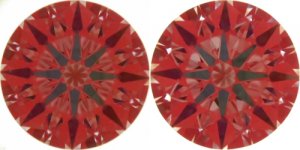- Joined
- Mar 28, 2001
- Messages
- 6,341
Hi Al,
Scroll on down.
----------------
On 1/15/2004 2:05:07 PM aljdewey wrote:
----------------
On 1/15/2004 12:14:34 PM Rhino wrote:
Aldejay... the repeatability of it is as excellent as any other technology for measuring diamonds----------------
But, Jonathan, that's precisely my point. It's may be as good as any other fancy 'technological tool', but that doesn't make any of them reliable enough to substitute for a hands-on (or more accurately, eyes-on) evaluation.
Yes but you are forgetting something. It's results correlate with human eye observation. I would agree there are some stones whose results it would be impossible to *see* but time and time again, when given the pepsi challenge the greater majority of our clients, when shown 2 H&A side by side with differing BrillianceScope results can and do see the difference. If it did not correlate with human eye observation it would be good for the trash as far as I'm concerned.
I noted that the same diamond can be scanned in the b/scope three separate times and yield three separate (and varying) results.
Oh really? Then either their machine was bogus or you have been given faulty information. I have ran the same diamond multiple times and get the same exact results every time. Even on a stone that was ran 6 months after I had ran it initially. If we were to break down the readings into L1, L2, L3, M1, M2, M3, H1, H2, H3, VH1, VH2, VH3 (Low = low, M = med, H = High, and VH = Very High) the greatest variance I have seen may be from H1 to H2 or H3 to VH1. Never and I repeat NEVER do they vary so much as to misrepresent the diamond being tested.
If you're telling me that the B/scope is as reliable as any other technology, then you're essentially saying that none of the technologies can produce repeatable results. There's a difference between something being 'good' and something being 'as good as anything else'.
That's not what I'm saying. What I am saying is that the BrillianceScope's repeatability is as better if not moreso than a Sarin or OGI machine. When you run the same exact diamond on a Sarin or OGI it is likely to get slightly different readings each time. Everyone who owns one knows this. However the slight differences from reading to reading do not misrepresent the diamond being tested. It is exactly the same with the BrillianceScope. Whoever told you this makes it sound like it gives wacky variances and different results each time and is a technology that is not to be trusted. This couldn't be further from the truth. I know because I use it daily and before I even commited to keeping the technology in our store I had tested many stones whose light return and brilliance I was already familiar with. If the technology couldn't be relied upon Aldejay I'd be the first to expose it's bogusness. Having had prior experience with the FireScope and then LightScope I was not walking into the learning of B'scope technology with no knowledge and the two explain each other.
Put another way: Assume I'm one of ten students taking an exam. I and the other nine students score 70 out of a possible 100 on the exam. The fact that I scored as well as any other student taking the test doesn't mean I did well on exam. Doing well on the exam would be scoring a 90 or better. Same thing with the B/Scope.
Not so. A diamond can not score well on the BrillianceScope if it is not displaying the proper optical properties. If light is not being returned through the crown at stronger or weaker intensities the diamond will not score appropriately. I have written a tutorial on this very subject and can show you diamond after diamond after diamond which score such and such on the BrillianceScope and more importantly show you why it scored as it did with LightScope.
Again, I'm not saying that information from the b/scope cannot be useful. I'm saying that a consumer should take this (and any other techie toy) with a grain of salt and look at the total picture when trying to select a diamond. If every indicator points to a diamond being a GREAT performer, but the b/scope shows 3 highs instead of 3 VHs......I think it would be a mistake to discard that diamond from consideration JUST because the b/scope results weren't VH.
Who said 3 Highs were bad? There are certain minimums we look for when we are performing an analysis and we do let our clients know what those minimums are via our tutorial on the B'scope. We show our clients any stones they want to see side by side and let them choose for themself. However many people can not come to our store and if they want a representation of how brilliant, how fiery, how scintillating a diamond is going to look in direct light conditions there is no better technology on the market to represent the beauty of the stone in those light conditions than the BrillianceScope. Multitudes of people have witnessed this for themselves who have come to see for themselves.
Aldejay ... have you actually compared 2 diamonds (or H&A's side by side) that did have varying BrillianceScope results to make the judgment for yourself?
Peace,
Rhino









300x240.png)